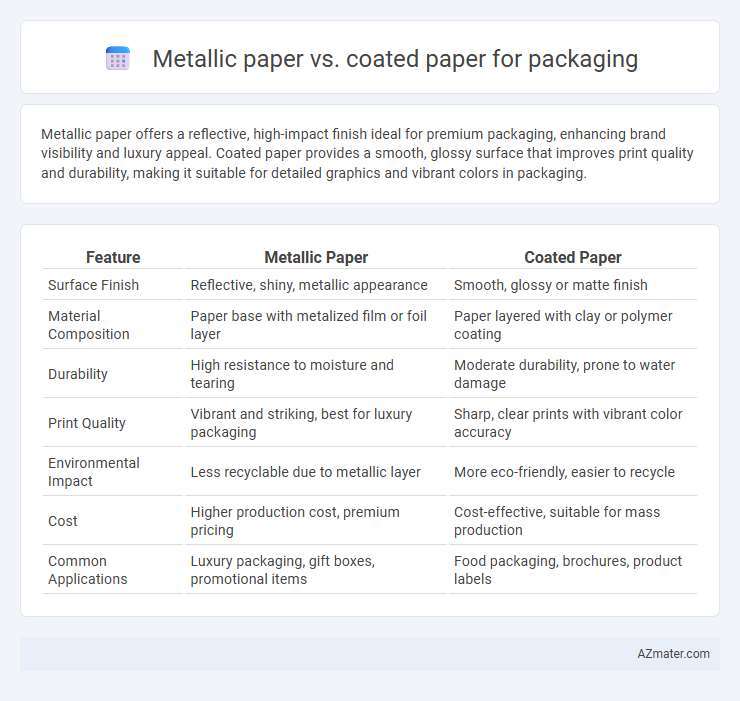Metallic paper offers a reflective, high-impact finish ideal for premium packaging, enhancing brand visibility and luxury appeal. Coated paper provides a smooth, glossy surface that improves print quality and durability, making it suitable for detailed graphics and vibrant colors in packaging.
Table of Comparison
| Feature | Metallic Paper | Coated Paper |
|---|---|---|
| Surface Finish | Reflective, shiny, metallic appearance | Smooth, glossy or matte finish |
| Material Composition | Paper base with metalized film or foil layer | Paper layered with clay or polymer coating |
| Durability | High resistance to moisture and tearing | Moderate durability, prone to water damage |
| Print Quality | Vibrant and striking, best for luxury packaging | Sharp, clear prints with vibrant color accuracy |
| Environmental Impact | Less recyclable due to metallic layer | More eco-friendly, easier to recycle |
| Cost | Higher production cost, premium pricing | Cost-effective, suitable for mass production |
| Common Applications | Luxury packaging, gift boxes, promotional items | Food packaging, brochures, product labels |
Introduction to Metallic and Coated Papers in Packaging
Metallic paper features a reflective surface created by a metalized layer, enhancing visual appeal and attracting consumer attention in packaging design. Coated paper has a smooth finish achieved by applying a coating of clay or polymers, providing excellent printability and durability for high-quality images and text. Both materials serve different packaging needs: metallic paper is ideal for luxury or promotional items, while coated paper offers versatility and cost-effectiveness for everyday packaging solutions.
Defining Metallic Paper: Features and Benefits
Metallic paper features a reflective, metalized surface that enhances visual appeal and provides superior durability for packaging. Its unique ability to reflect light increases product shelf impact and conveys a premium brand image. This paper also offers improved resistance to moisture and tearing compared to standard coated paper, making it ideal for high-end or luxury packaging applications.
Understanding Coated Paper: Types and Applications
Coated paper, available in gloss, matte, and satin finishes, is engineered to enhance print quality and durability in packaging applications by providing a smooth surface that improves color vibrancy and sharpness. Widely used in product packaging, brochures, and labels, coated paper types such as clay-coated and polymer-coated offer varying levels of water resistance and stiffness, tailored to specific packaging needs. This versatility makes coated paper a preferred choice for packaging that requires high visual appeal and functional protection, distinguishing it from metallic paper which emphasizes reflective and decorative effects.
Visual Appeal: Shine, Texture, and Print Quality Comparison
Metallic paper offers a distinctive sheen and reflective shine that enhances packaging's visual appeal, making colors appear more vibrant and luxurious, while coated paper provides a smooth, matte or glossy finish that ensures consistent color accuracy and sharpness. The texture of metallic paper is often slightly embossed or grainy, which adds tactile interest, whereas coated paper tends to have a uniform surface that supports high-resolution printing and detailed graphics. Print quality on metallic paper can sometimes cause color shifts due to its reflective nature, but coated paper excels in maintaining color fidelity and crisp images, ideal for intricate designs and brand clarity.
Performance in Packaging: Durability and Protection
Metallic paper offers superior durability and moisture resistance compared to coated paper, making it ideal for packaging that demands enhanced protection against environmental factors. Its unique metallic layer provides excellent barrier properties, preventing contamination and preserving product freshness. Coated paper, while providing a smooth surface and good print quality, generally lacks the robust protective qualities essential for heavy-duty packaging applications.
Cost Analysis: Metallic Paper vs Coated Paper
Metallic paper typically incurs higher production costs due to specialized materials and complex manufacturing processes compared to coated paper, which offers more economical options for large-scale packaging. Coated paper provides effective print quality and durability at a lower price point, making it suitable for budget-sensitive packaging projects. Choosing between metallic and coated paper requires balancing premium aesthetic appeal with cost efficiency to meet specific packaging needs.
Sustainability and Environmental Impact
Metallic paper, often coated with aluminum or synthetic layers, poses greater challenges for recycling due to its non-biodegradable and chemically complex components, leading to increased environmental impact compared to coated paper. Coated paper, especially when made with biodegradable or recycled fibers and eco-friendly coatings like clay or starch, offers improved sustainability by facilitating easier recycling and reducing landfill waste. Choosing coated paper with certified sustainable sourcing further minimizes carbon footprint and conserves natural resources in packaging applications.
Customization and Branding Opportunities
Metallic paper offers enhanced customization options with its reflective surface that elevates brand visibility through vibrant colors and unique textures, making it ideal for luxury packaging and high-impact branding. Coated paper provides a smooth finish that supports precise graphic reproduction and versatile printing techniques, enabling detailed logos and colorful designs to stand out effectively. Both materials enhance branding but metallic paper is preferred for premium, attention-grabbing packaging, while coated paper suits brands seeking crisp, polished visuals.
Industry Trends in Packaging Paper Choices
Metallic paper in packaging offers a premium, eye-catching finish preferred for luxury products, while coated paper remains dominant due to its versatility and cost-efficiency across various packaging sectors. Industry trends highlight a growing demand for sustainable coated paper variants with enhanced printability and durability, driven by eco-conscious consumer preferences. Advances in coating technology are narrowing the visual and tactile gap between metallic and coated papers, influencing packaging designers to balance aesthetics with environmental impact.
Making the Right Choice: Factors to Consider for Your Packaging
Metallic paper offers a shiny, reflective finish ideal for luxury packaging, enhancing brand appeal and perceived value, while coated paper provides a smooth, matte or gloss surface suited for vibrant printing and durability. Consider factors such as product type, target audience, budget, print quality requirements, and environmental impact when choosing between metallic and coated paper. Evaluating these elements ensures packaging aligns with brand identity and functional needs, optimizing both aesthetics and performance.

Infographic: Metallic paper vs Coated paper for Packaging
 azmater.com
azmater.com